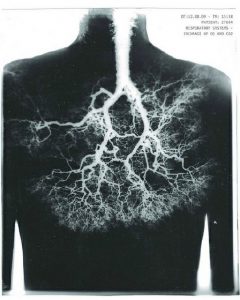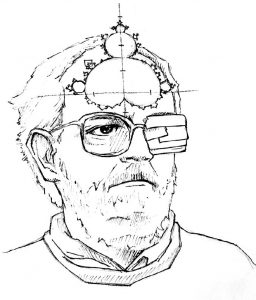by Jory Pomeranz
In some old encyclopedias, you will find under the article on Spain, the border between Spain and Portugal is 620 miles long. In the same encyclopedia, under the article on Portugal, it says the border is 760 miles long. It’s the same border. The geometry we learned in high school—circles, squares, triangles—tells us nothing about the shapes of nature. Where the land and sea so variously lie about each other and lightly kiss is no hyperbola. If you measure in kilometers, you reach a certain length. In meters, you’d pick up more wiggles and wobbles of the coastline. Centimeters? Even longer. There is no well-defined length for a coastline; the length depends on the scale by which you choose to measure it and the scale of your perspective. This is called scale ambiguity.
Michael Crane was a mathematician studying and teaching fractal geometry at Cornell University. Fractals are great for finding simple descriptions for complicated shapes. Take Sierpinski’s gasket, for example. The gasket possesses an infinite number of triangles, and the equations of those triangles aren’t straightforward. Yet if you shrink it by a half, take another copy and shrink it by a half, then move it over by half, and then take a final copy, shrink it by a half, and move up by a half, you get the gasket. A fractal description of an object is the story of how it grows.
I learned from Michael he was dying of cancer and it was everywhere. It was inside his brain; it had taken one eye, which he hid by covering his glasses with duct tape and joking about being a pirate. It was all over his lungs and he would exclaim, “Our lungs, oh my God! There are half a billion alveoli in our lungs—it would take the whole genome  just to describe the lungs! That’s why the genome just tells us how to grow instead. If we take these structures apart, study the patterns in smaller scales, anything visually complex can be decoded into something very simple.” And he’d be totally out of breath, and I could see and feel it hurt him now, every time he chose to use those lungs to speak. There are, on average, twenty-three levels of branching in the lungs, and they have a volume of five to six liters and a surface area of 130 square meters. It’s like taking an envelope and folding it up to fit inside a thimble, yet evolution discovered a way to do it by branching, and branching, and branching. Every bit of the lung looks like the whole lung. It’s a fractal and dually simple and complex.
just to describe the lungs! That’s why the genome just tells us how to grow instead. If we take these structures apart, study the patterns in smaller scales, anything visually complex can be decoded into something very simple.” And he’d be totally out of breath, and I could see and feel it hurt him now, every time he chose to use those lungs to speak. There are, on average, twenty-three levels of branching in the lungs, and they have a volume of five to six liters and a surface area of 130 square meters. It’s like taking an envelope and folding it up to fit inside a thimble, yet evolution discovered a way to do it by branching, and branching, and branching. Every bit of the lung looks like the whole lung. It’s a fractal and dually simple and complex.
* * *
With Michael’s disease progressing, I wondered how much of his nature, nature itself would have to destroy before his childlike curiosity for nature itself would be destroyed. He still had this gentle, vivacious curiosity in a dying body. As a child, he had wanted to understand the different shapes of clouds, or why flowers grew the way they grew, or why mud cracked the way it did when it dried out in the sun. As an adult, he wanted to be that tottering old guy ambling into class with a piece of toilet paper stuck to his shoe, still telling the same dumb jokes. And the sicker he got, the more I wanted to walk the measuring tape back on his life, giving him more time with his wife and his seven cats.
Michael taught me that science has a narrative component that we too often forget. He was a storyteller. The shape of a snowflake is the story of the pressure, temperature, and humidity it encountered on its flight through the clouds. A coastline is the story of rocks and tides and waves. A mountain range is the story about plate tectonics and erosion. A child’s face, a field of daisies, a fall of snowflakes: bilateral symmetry for the human face, translational symmetry for the field of daisies, rotational symmetry for the snowflakes. Fractals.
Near the end of his life, they took one of his arms. He used the one arm to walk with a cane. He told me, “I feel disgusted that I’m being betrayed by my body,” and I knew he understood it was by the nature he found so beautiful. Cancer cells are fractals too. He died a few days afterward at night. I sat on my porch. I cried because I felt it was unfair for a man to understand so much about the uncontrolled elements of life and still have to die. I looked up at the night. I had this very clear sense that instead of looking up into the heights, I was looking down into the depths—something flipped, and the space between the stars was just immense and empty, but there was something else to it too. And I couldn’t explain it. And I missed him already.
Category: Short Story, SNHU Creative Writing, SNHU online creative writing

